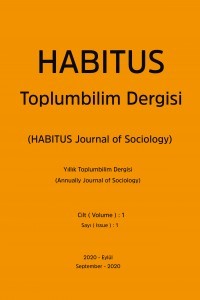LIVING IN THE MARGINS: DISABILITY AND THE PANDEMIC
Disability, Pandemic, Peripheralization
LIVING IN THE MARGINS: DISABILITY AND THE PANDEMIC
COVID, PANDEMIC, DISABILITY,
___
- Hossain, M. S., Ferdous, S., and Siddiqee, M. (2020). Mass panic during COVID-19 outbreak–A perspective from Bangladesh as a high-risk country. J. Biomed. Analyt. 3 (2), 1–3.
- ICF: An Overview. PTC Working Paper. https://www.cdc.gov/nchs/data/icd/icfoverview_finalforwho10sept.pdf (Access 12.02.22).
- John, D, Narassima, M.S, Menon J, et al. (2021). Estimation of the economic burden of COVID-19 using disability-adjusted life years (DALYs) and productivity losses in Kerala, India: a model-based analysis. BMJ Open, https://bmjopen.bmj.com/content/11/8/e049619 (Access 07.02.22).
- Kidd, S., Wapling, L., Schjoedt, R. and Gelders, B. (2019). Leaving no-one behind: building inclusive social protection systems for persons with disabilities. Development Pathways.
- Kühn, M. (2014): Peripheralization: Theoretical Concepts Explaining Socio-Spatial Inequalities, European Planning Studies, DOI: 10.1080/09654313.2013.862518, http://dx.doi.org/10.1080/09654313.2013.862518 (Access on 14.02.22).
- McDougall J, Wright V, Rosenbaum P. (2010). The ICF model of functioning and disability: incorporating quality of life and human development. Developmental Neurorehabilitation., 13(3):204-211. DOI: 10.3109/17518421003620525
- Meaney-Davis, J. (2020) The financial and economic impacts of the COVID-19 pandemic on people with disabilities in low- and middle-income countries, Disability Inclusion Helpdesk Research Report No. 42. London, UK: Disability Inclusion Helpdesk.
- Ozili, P. K., and Arun, T. (2020). Spillover of COVID-19: impact on the global economy. https://papers.ssrn.com/sol3/papers.cfm?abstract_id3562570 (Access 05.02.22).
- Mowat, J. G. (2015). Towards a new conceptualisation of marginalisation. European Educational Research Journal, 14(5), 454–476. https://doi.org/10.1177/1474904115589864 (Access on 15.02.22).
- Messiou K. (2012). Collaborating with children in exploring marginalisation: An approach to inclusive education. International Journal of Inclusive Education 16(12): 1311–1322.
- Rasul, G. (2020). A framework for improving policy priorities in managing COVID-19 challenges in developing countries. Frontiers in Public Health. 8, https://doi.org/10.3389/fpubh.2020.589681 (Access 03.02.22).
- Rasul G, Nepal AK, Hussain A, et. al. (2021). Socio-Economic Implications of COVID-19 Pandemic in South Asia: Emerging Risks and Growing Challenges. Frontiers in Sociology. https://doi.org/10.3389/fsoc.2021.629693 (Access 05.02.22).
- UNDESA (United Nations Department of Economic and Social Affairs) (2019). Disability and Development Report: realising the Sustainable Development Goals by, for and with persons with disabilities. https://social.un.org/publications/UN-Flagship-Report-Disability-Final.pdf (Access 05.02.22).
- Wacquant, L. (2008). Urban Outcasts. A comparative Sociology of Advanced Marginality, Cambridge: Polity Press.
- ISSN: 2718-0433
- Yayın Aralığı: Yıllık
- Başlangıç: 2020
- Yayıncı: Mine ALPTEKİN
BAUMAN’NIN ÖZGÜRLÜK VE BELİRSİZLİK ANLAYIŞINDA İŞSİZLİK VE COVİD 19 PANDEMİSİ ETKİSİ
MEKÂN VE PANDEMİ: DEĞİŞEN ROLLER VE DÖNÜŞEN EVİN HALLERİ
ÖĞRETMENLERİN TEMEL SORUNLARI TRABZON VE AKÇAABAT İLÇESİ ÖRNEĞİ
PANDEMİ SÜRECINDE BİLIMİ ANLAMLANDIRMAK: BİLİMİN SOSYAL KARAKTERİ VE BİLİM TOPLULUĞUNUN DOĞASI
THE COVID-19 AND ITS IMPACT ON INDIAN SOCIAL LIFE: LIVED EXPERIENCES OF MUSLIMS AND DALIT COMMUNITY
GIVING BACK TO HUMANITY IN COVID-19 TIMES - AN INITIATIVE OF BMDA IN THE CITY OF VADODARA
Tanveer QURESHİ, Nabila QURESHİ
MENTAL HEALTH'S STRENGTHENING IN THE PERIOD OF COVID-19
RE-ORIENTING CURRICULUM OF TOURISM EDUCATION IN THE CONTEXT OF COVID-19: AN EMPIRICAL STUDY
Venkata Rao YEDLA, E Joshu AJOON
TURİZMDE KURUMSAL HABİTUS: ÖZEL ÜNİVERSİTE VE DEVLET ÜNİVERSİTESİ ARASINDA BİR KARŞILAŞTIRMA
